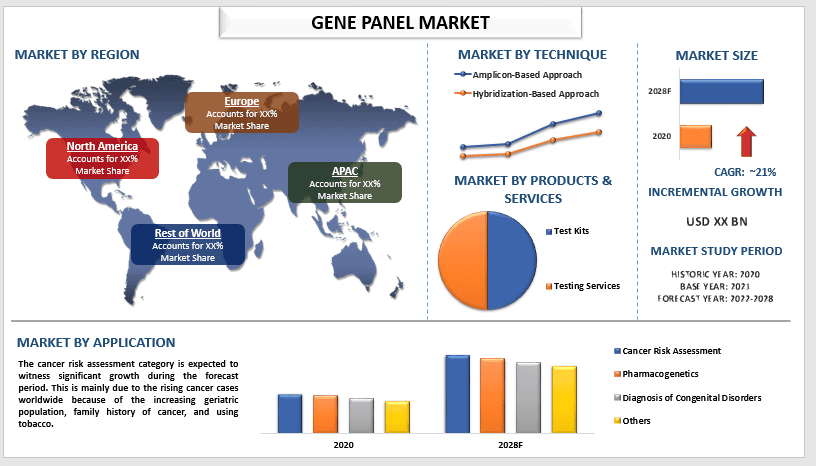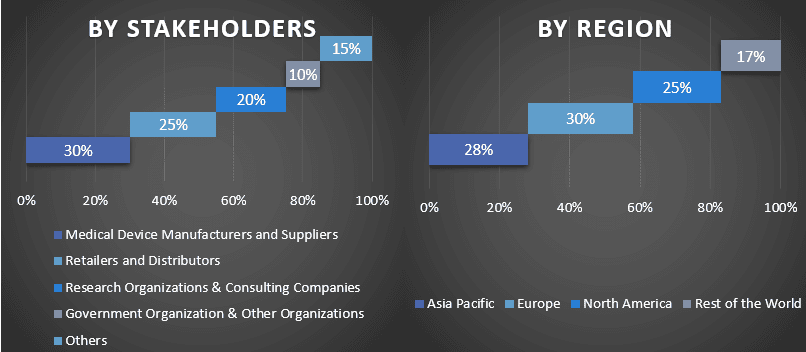- الرئيسية
- معلومات عنا
- صناعة
- الخدمات
- قراءة
- اتصل بنا
سوق لوحات الجينات: التحليل الحالي والتوقعات (2022-2028)
التركيز على المنتجات والخدمات (مجموعات الاختبار وخدمات الاختبار)؛ التقنية (النهج القائم على الأمبليكون والنهج القائم على التهجين)؛ التطبيق (تقييم خطر الإصابة بالسرطان، وعلم الوراثة الدوائية، وتشخيص الاضطرابات الخلقية، وغيرها)؛ المستخدم النهائي (المستشفيات، ومختبرات التشخيص، وشركات الأدوية، وغيرها)؛ والمنطقة/الدولة

من المتوقع أن ينمو سوق الألواح الجينية العالمي بمعدل كبير يبلغ حوالي 21٪ خلال الفترة المتوقعة. اللوح الجيني هو اختبار معملي يتم فيه دراسة العديد من الجينات في عينة من الأنسجة. تساعد اختبارات اللوحات متعددة الجينات في العثور على الطفرات في بعض الجينات التي قد تزيد من خطر إصابة الشخص بمرض مثل السرطان. توفر الألواح الجينية تسلسلًا للجينات مثل BRCA1 و BRCA2 والتي ثبت أنها متورطة في خطر الإصابة بالأمراض، وتسلسل الجينوم في الجينوم. بالإضافة إلى ذلك، فإن ارتفاع حالات السرطان بين السكان، أو الانتشار العالي للأمراض المزمنة هي العامل الرئيسي لنمو هذا السوق خلال الفترة المتوقعة. على سبيل المثال، وفقًا للبيانات المقدمة من الوكالة الدولية لأبحاث السرطان (IRAC) في عام 2018، تشير التقديرات إلى أنه سيكون هناك أكثر من 27.5 مليون حالة سرطان جديدة بحلول عام 2040، والتي ستكون بشكل رئيسي بسبب عوامل مثل نمط الحياة غير الصحي والتدخين وتقليل النشاط البدني والاضطرابات الوراثية.
تعتبر شركات Illumina Inc. و BGI و Agilent Technologies Inc. و Eurofins Scientific SE و QIAGEN و GENEWIZ Inc. و Novogene Corporation و Personalis Inc. و Thermo Fisher Scientific و F. Hoffmann-La Roche AG. من اللاعبين الرئيسيين في السوق. وقد قامت هذه الشركات بالعديد من عمليات الاندماج والاستحواذ إلى جانب الشراكات لتزويد العملاء بمنتجات/تقنيات عالية التقنية ومبتكرة.
رؤى مقدمة في التقرير
"من بين المنتجات والخدمات، من المتوقع أن تشهد فئة مجموعات الاختبار معدل نمو سنوي مركب قوي خلال الفترة المتوقعة"
استنادًا إلى النوع، يتم تقسيم السوق إلى مجموعات اختبار وخدمات اختبار. من بين هؤلاء، من المتوقع أن تشهد فئة مجموعات الاختبار معدل نمو سنوي مركب أعلى خلال الفترة المتوقعة. ويرجع ذلك أساسًا إلى تزايد الأمراض المزمنة وأمراض القلب والأوعية الدموية ومتلازمة داون ومرض هنتنغتون والتليف الكيسي ومرض الخلايا المنجلية في جميع أنحاء العالم. بالإضافة إلى ذلك، من المتوقع أيضًا أن يؤدي تزايد أنشطة البحث والتطوير بالإضافة إلى ارتفاع الطلب على اختبارات التشخيص الجيني في المختبرات إلى دفع الطلب على سوق الألواح الجينية خلال الفترة المتوقعة. على سبيل المثال، وفقًا لاتفاقية ILAC MRA (التعاون الدولي لاعتماد المختبرات) والموقعين عليها، في عام 2021، تم اعتماد ما يقرب من 85000 مختبر، وما يقرب من 13000 هيئة تفتيش، وأكثر من 600 مزود لاختبارات الكفاءة، و 250 منتجًا للمواد المرجعية على مستوى العالم.
"من بين التقنيات، من المتوقع أن تحتفظ الطريقة القائمة على الأمبليكون بحصة كبيرة في السوق في عام 2020"
على أساس التقنية، يتم تصنيف السوق إلى الطريقة القائمة على الأمبليكون والطريقة القائمة على التهجين. من بين هؤلاء، تحتفظ فئة الطريقة القائمة على الأمبليكون بحصة كبيرة خلال الفترة المتوقعة. تستخدم الطريقة القائمة على الأمبليكون مجسات قليلة النوكليوتيدات مصممة لاستهداف والتقاط المناطق ذات الأهمية، متبوعة بتسلسل الجيل التالي (NGS) وهي مفيدة أيضًا لاكتشاف الطفرات الجسدية النادرة في العينات المعقدة. بالإضافة إلى ذلك، يتم استخدام الطريقة القائمة على الأمبليكون للكشف عن مرض الزهايمر والتصلب المتعدد ومرض هنتنغتون ومرض باركنسون. على سبيل المثال، يتم تشخيص إصابة ما يقرب من 60000 أمريكي بمرض باركنسون كل عام ويعيش أكثر من 10 ملايين شخص حول العالم مصابين بمرض باركنسون.
"من بين التطبيقات، من المتوقع أن يحتفظ تقييم خطر الإصابة بالسرطان بحصة كبيرة في السوق في عام 2020"
على أساس التطبيق، يتم تصنيف السوق إلى تقييم خطر الإصابة بالسرطان، وعلم الصيدلة الجيني، وتشخيص الاضطرابات الخلقية، وغيرها. من بين هؤلاء، تحتفظ فئة تقييم خطر الإصابة بالسرطان بحصة كبيرة خلال الفترة المتوقعة. ويرجع ذلك أساسًا إلى ارتفاع أمراض القلب والأوعية الدموية والتليف الكيسي ومرض هنتنغتون وأنواع السرطان المختلفة مثل سرطان الرئة وسرطان الثدي وسرطان البروستاتا وما إلى ذلك. هذه العوامل تدفع نمو هذا السوق خلال الفترة المتوقعة. على سبيل المثال، في عام 2020، تم تشخيص إصابة 2.3 مليون امرأة بسرطان الثدي و 685000 حالة وفاة على مستوى العالم. اعتبارًا من نهاية عام 2020، كان هناك 7.8 مليون امرأة على قيد الحياة تم تشخيص إصابتهن بسرطان الثدي في السنوات الخمس الماضية، مما يجعله السرطان الأكثر انتشارًا في العالم.
"من بين المستخدمين النهائيين، من المتوقع أن تحتفظ المستشفيات بحصة كبيرة في السوق في عام 2020"
على أساس المستخدم النهائي، يتم تصنيف السوق إلى المستشفيات والمختبرات التشخيصية وشركات الأدوية وغيرها. من بين هؤلاء، تحتفظ فئة المستشفيات بحصة سوقية كبيرة خلال الفترة المتوقعة. يتم دفع هذه الفئة بشكل خاص من خلال العدد الأكبر من المرضى الذين يعانون من حالات خطيرة، وقد كان المرضى محوريين في زيادة الطلب على اختبار الألواح الجينية على مستوى العالم. بالإضافة إلى ذلك، فإن نمو هذا القطاع يرجع إلى تحسين العلاج وتوافر المعدات والمهنيين المهرة في المستشفيات هي الأسباب الرئيسية لنمو هذا القطاع. بالإضافة إلى ذلك، فإن ارتفاع معدل انتشار السرطان في جميع أنحاء العالم، وخاصة في البلدان المتقدمة. على سبيل المثال، وفقًا لإحصائيات منظمة الصحة العالمية (WHO)، تم تسجيل 2.26 حالة جديدة لسرطان الثدي في عام 2020.
"من المتوقع أن تحتفظ أمريكا الشمالية بحصة كبيرة في السوق"
في عام 2020، احتلت أمريكا الشمالية حصة كبيرة من سوق الألواح الجينية العالمي. يتم تحليل السوق بناءً على وجودها في جميع أنحاء العالم في بلدان مثل أمريكا الشمالية (الولايات المتحدة وكندا وبقية أمريكا الشمالية) وأوروبا (ألمانيا والمملكة المتحدة وفرنسا وإسبانيا وإيطاليا وبقية أوروبا) وآسيا والمحيط الهادئ (الصين واليابان والهند وبقية منطقة آسيا والمحيط الهادئ) وبقية العالم. من المتوقع أن تنمو أمريكا الشمالية بمعدل نمو سنوي مركب كبير خلال الفترة المتوقعة. إدارة المستشفيات الكبيرة للمرضى، وزيادة الطلب على أجهزة التشخيص بسبب ارتفاع حالات السرطان والأمراض المزمنة، ووجود الشركات المصنعة للأجهزة الطبية في المنطقة. على سبيل المثال، في سبتمبر 2020، أعلنت شركة Bionano Genomics، وهي شركة أمريكية لتصنيع التشخيصات الجينومية، عن إطلاق EpiPanelDx PLUS، وهو اختبار لوحة جينية لتشخيص الصرع. علاوة على ذلك، من المتوقع أن يستمر السوق في النمو بمعدل ثابت خلال الفترة المتوقعة نظرًا لارتفاع مستويات دخل المستهلكين في المنطقة جنبًا إلى جنب مع زيادة الوعي بأهمية قضاء الوقت في الأنشطة الترفيهية الخارجية من أجل حياة متوازنة وصحية.
أسباب شراء هذا التقرير:
- تتضمن الدراسة تحليل تقدير حجم السوق والتنبؤ به والذي تم التحقق منه من قبل خبراء الصناعة الرئيسيين الموثوق بهم.
- يقدم التقرير مراجعة سريعة للأداء العام للصناعة في لمحة واحدة.
- يغطي التقرير تحليلًا متعمقًا لأقران الصناعة البارزين مع التركيز الأساسي على البيانات المالية الرئيسية للأعمال ومجموعة المنتجات واستراتيجيات التوسع والتطورات الحديثة.
- فحص مفصل للدوافع والقيود والاتجاهات الرئيسية والفرص السائدة في الصناعة.
- تغطي الدراسة بشكل شامل السوق عبر مختلف القطاعات.
- تحليل متعمق على المستوى الإقليمي للصناعة.
خيارات التخصيص:
يمكن زيادة تخصيص سوق الألواح الجينية العالمي وفقًا للمتطلبات أو أي قطاع سوق آخر. إلى جانب ذلك، تدرك UMI أن لديك احتياجات عمل خاصة بك، لذا لا تتردد في التواصل معنا للحصول على تقرير يناسب متطلباتك تمامًا.
جدول المحتويات
منهجية البحث لتحليل سوق لوحة الجينات (2022-2028)
كان تحليل السوق التاريخية وتقدير السوق الحالية والتنبؤ بالسوق المستقبلية لسوق لوحة الجينات العالمية هي الخطوات الرئيسية الثلاث التي تم اتخاذها لإنشاء وتحليل اعتماد لوحات الجينات في المناطق الرئيسية على مستوى العالم. تم إجراء بحث ثانوي شامل لجمع أرقام السوق التاريخية وتقدير حجم السوق الحالي. ثانيًا، للتحقق من صحة هذه الرؤى، تم أخذ العديد من النتائج والافتراضات في الاعتبار. علاوة على ذلك، تم إجراء مقابلات أولية شاملة أيضًا مع خبراء الصناعة عبر سلسلة القيمة لسوق لوحة الجينات العالمية. بعد افتراض أرقام السوق والتحقق من صحتها من خلال المقابلات الأولية، استخدمنا نهجًا تصاعديًا/تنازليًا للتنبؤ بحجم السوق الكامل. بعد ذلك، تم اعتماد طرق تقسيم السوق وتثليث البيانات لتقدير وتحليل حجم السوق للقطاعات والقطاعات الفرعية التي تنتمي إليها الصناعة. يتم شرح المنهجية التفصيلية أدناه:
تحليل حجم السوق التاريخي
الخطوة 1: دراسة متعمقة للمصادر الثانوية:
تم إجراء دراسة ثانوية مفصلة للحصول على حجم السوق التاريخي لسوق لوحة الجينات من خلال مصادر الشركة الداخلية مثل التقارير السنوية والبيانات المالية وعروض الأداء والبيانات الصحفية وما إلى ذلك، والمصادر الخارجية بما في ذلك المجلات والأخبار والمقالات والمنشورات الحكومية ومنشورات المنافسين وتقارير القطاعات وقاعدة بيانات الطرف الثالث والمنشورات الموثوقة الأخرى.
الخطوة 2: تجزئة السوق:
بعد الحصول على حجم السوق التاريخي لسوق لوحة الجينات، أجرينا تحليلًا ثانويًا تفصيليًا لجمع رؤى السوق التاريخية ومشاركتها للقطاعات والقطاعات الفرعية المختلفة للمناطق الرئيسية. يتم تضمين القطاعات الرئيسية في التقرير كمنتجات وخدمات وتقنية وتطبيق ومستخدم نهائي. تم إجراء المزيد من التحليلات على مستوى الدولة لتقييم الاعتماد العام لنماذج الاختبار في تلك المنطقة.
الخطوة 3: تحليل العوامل:
بعد الحصول على حجم السوق التاريخي للقطاعات والقطاعات الفرعية المختلفة، أجرينا تحليلًا تفصيليًا للعوامل لتقدير حجم السوق الحالي لسوق لوحة الجينات. علاوة على ذلك، أجرينا تحليلًا للعوامل باستخدام متغيرات تابعة ومستقلة مثل المنتجات والخدمات المختلفة والتقنية والتطبيق والمستخدم النهائي للوحة الجينات. تم إجراء تحليل شامل لسيناريوهات جانب الطلب والعرض مع مراعاة أهم الشراكات وعمليات الاندماج والاستحواذ والتوسع التجاري وإطلاق المنتجات في قطاع سوق لوحة الجينات في جميع أنحاء العالم.
تقدير حجم السوق الحالي والتنبؤ به
تحديد حجم السوق الحالي: بناءً على رؤى قابلة للتنفيذ من الخطوات الثلاث المذكورة أعلاه، توصلنا إلى حجم السوق الحالي واللاعبين الرئيسيين في سوق لوحة الجينات العالمية والحصص السوقية للقطاعات. تم تحديد جميع النسب المئوية المطلوبة والانقسامات وتقسيمات السوق باستخدام النهج الثانوي المذكور أعلاه وتم التحقق منها من خلال المقابلات الأولية.
التقدير والتنبؤ: لتقدير السوق والتنبؤ بها، تم تخصيص أوزان لعوامل مختلفة بما في ذلك المحركات والاتجاهات والقيود والفرص المتاحة لأصحاب المصلحة. بعد تحليل هذه العوامل، تم تطبيق تقنيات التنبؤ ذات الصلة، أي النهج التصاعدي/التنازلي للوصول إلى توقعات السوق لعام 2027 للقطاعات والقطاعات الفرعية المختلفة عبر الأسواق الرئيسية على مستوى العالم. تتضمن منهجية البحث المعتمدة لتقدير حجم السوق ما يلي:
- حجم سوق الصناعة، من حيث الإيرادات (بالدولار الأمريكي) ومعدل اعتماد سوق لوحة الجينات عبر الأسواق الرئيسية محليًا
- جميع النسب المئوية والتقسيمات والتقسيمات الفرعية لقطاعات السوق والقطاعات الفرعية
- اللاعبون الرئيسيون في سوق لوحة الجينات العالمية من حيث المنتجات المعروضة. أيضًا، استراتيجيات النمو التي يتبناها هؤلاء اللاعبون للمنافسة في السوق سريعة النمو
التحقق من صحة حجم السوق وحصتها
البحث الأولي: تم إجراء مقابلات متعمقة مع قادة الرأي الرئيسيين (KOLs) بما في ذلك كبار المسؤولين التنفيذيين (CXO/VPs، رئيس المبيعات، رئيس التسويق، الرئيس التنفيذي للعمليات، الرئيس الإقليمي، رئيس الدولة، إلخ) عبر المناطق الرئيسية. تم بعد ذلك تلخيص نتائج البحث الأولي وإجراء تحليل إحصائي لإثبات الفرضية المذكورة. تم دمج المدخلات من البحث الأولي مع النتائج الثانوية، وبالتالي تحويل المعلومات إلى رؤى قابلة للتنفيذ.
تقسيم المشاركين الأساسيين في مناطق مختلفة

هندسة السوق
تم استخدام تقنية تثليث البيانات لإكمال تقدير السوق الإجمالي والوصول إلى أرقام إحصائية دقيقة لكل قطاع وفرع فرعي من سوق لوحة الجينات العالمية. تم تقسيم البيانات إلى عدة قطاعات وقطاعات فرعية بعد دراسة المعايير والاتجاهات المختلفة في مجالات المنتجات والخدمات والتقنية والتطبيق والمستخدم النهائي في سوق لوحة الجينات العالمية.
الهدف الرئيسي من دراسة سوق لوحة الجينات العالمية
تم تحديد اتجاهات السوق الحالية والمستقبلية لسوق لوحة الجينات العالمية في الدراسة. يمكن للمستثمرين الحصول على رؤى استراتيجية لأساس تقديرهم للاستثمارات على التحليل النوعي والكمي الذي تم إجراؤه في الدراسة. حددت اتجاهات السوق الحالية والمستقبلية الجاذبية الإجمالية للسوق على المستوى الإقليمي، مما يوفر منصة للمشارك الصناعي لاستغلال السوق غير المستغل للاستفادة من ميزة المحرك الأول. تشمل الأهداف الكمية الأخرى للدراسات ما يلي:
- تحليل حجم السوق الحالي والمتوقع لسوق لوحة الجينات من حيث القيمة (بالدولار الأمريكي). أيضًا، قم بتحليل حجم السوق الحالي والمتوقع للقطاعات والقطاعات الفرعية المختلفة
- تشمل القطاعات في الدراسة مجالات المنتجات والخدمات والتقنية والتطبيق والمستخدم النهائي.
- تحديد وتحليل الإطار التنظيمي للوحة الجينات
- تحليل سلسلة القيمة التي تنطوي على وجود وسطاء مختلفين، إلى جانب تحليل سلوكيات العملاء والمنافسين في الصناعة.
- تحليل حجم السوق الحالي والمتوقع لسوق لوحة الجينات للمنطقة الرئيسية.
- تشمل الدول الرئيسية في المناطق التي تمت دراستها في التقرير منطقة آسيا والمحيط الهادئ وأوروبا وأمريكا الشمالية وبقية العالم.
- ملفات تعريف الشركة لسوق لوحة الجينات واستراتيجيات النمو التي يتبناها اللاعبون في السوق للاستمرار في السوق سريعة النمو
- تحليل متعمق على المستوى الإقليمي للصناعة
ذات صلة التقارير
العملاء الذين اشتروا هذا المنتج اشتروا أيضًا










